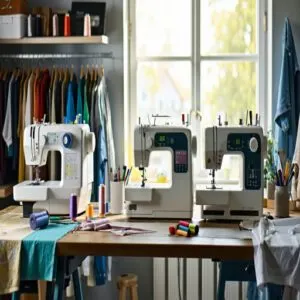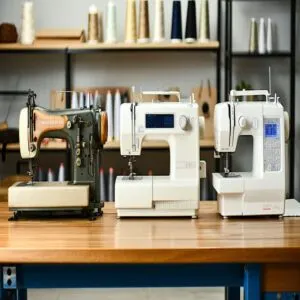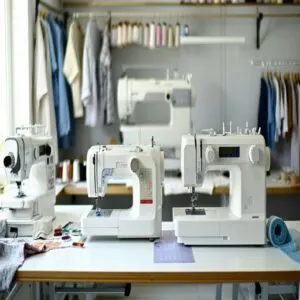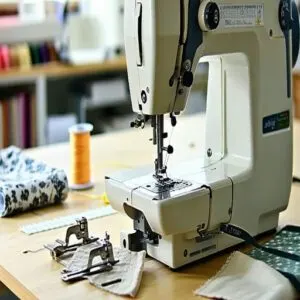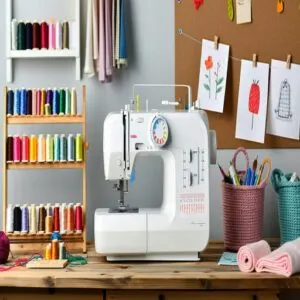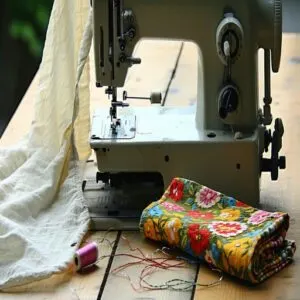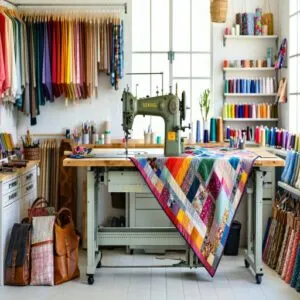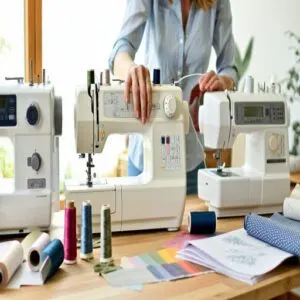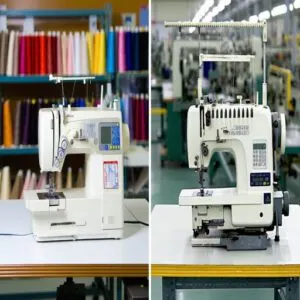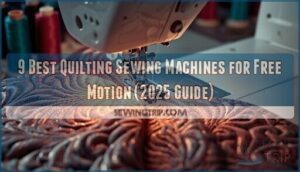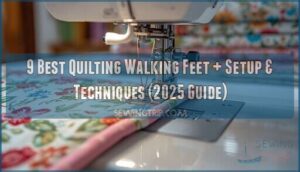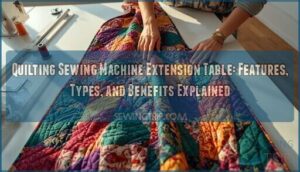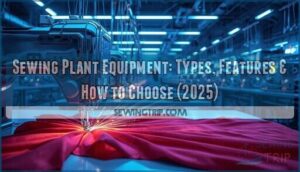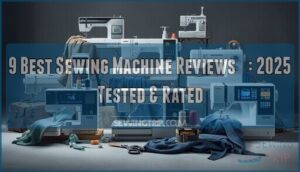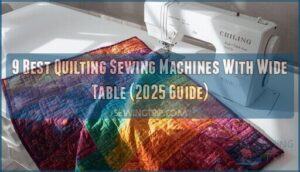This site is supported by our readers. We may earn a commission, at no cost to you, if you purchase through links.
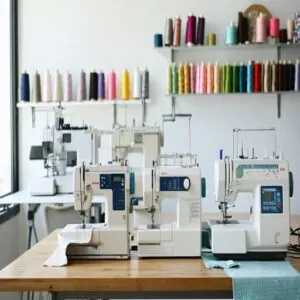 Figuring out what type of sewing machine you need starts with your projects and skills.
Figuring out what type of sewing machine you need starts with your projects and skills.
For beginner stuff like hemming pants or simple crafts, a standard household machine is your best buddy.
Tackling thick fabrics like denim? You’ll need a heavy-duty machine with a strong motor.
Dreaming of fancy embroidery? Go for a computerized embroidery machine.
If polished edges are your vibe, a serger works wonders.
Think about your space too—those machines can be bulky!
Whether you’re a quilting queen or leather enthusiast, match the machine to your needs.
And don’t forget: a good fit now saves frustration later!
Table Of Contents
Key Takeaways
- Match your sewing machine to your projects: household machines work for basics, heavy-duty ones handle thick fabrics, and embroidery or serger machines cater to specific needs.
- Budget wisely: basic models cost $100-$500, while advanced features like computerized stitching can push prices higher.
- Focus on essential features: look for adjustable stitch width, automatic threaders, and versatile presser feet to make sewing easier.
- Maintain your machine: clean lint, oil parts sparingly, replace needles often, and protect it from dust to ensure long-term efficiency.
Sewing Machine Types
Choosing a sewing machine starts with understanding the different types and what they’re designed for.
From standard models for everyday use to heavy-duty machines for thick fabrics, there’s a perfect fit for every project.
Standard Household Machines
Why choose a household sewing machine? They’re perfect for quick clothing fixes, creating curtains, or beginner projects.
These machines are light, affordable, and packed with essentials like straight and zigzag stitches.
For a closer examination into choosing a machine, explore this helpful sewing machine buying guide.
Want smooth hems? Add a twin needle. Ideal for small spaces, they’re great for hobbyists learning the ropes or seasoned crafters needing reliable home sewing tips.
Heavy Duty Machines
Got big plans with thick fabrics or leather crafting? A heavy duty sewing machine is your best buddy.
Thanks to industrial strength and heavy duty motors, these machines handle tough tasks like sewing multiple layers.
Their metal frame construction keeps them stable, even during long projects.
Perfect for upholstery, denim, or even mass production sewing—speedy, sturdy, unstoppable.
When choosing the right machine, consider the features of a best heavy duty sewing machine to guarantee it meets your needs for handling tough fabrics and producing high-quality stitches.
Embroidery Machines
Ready to add flair to your projects? An embroidery sewing machine combines creativity with precision, perfect for monogramming or detailed designs.
You’ll find options ranging from beginner-friendly single-needle models to sewing-embroidery combos with Embroidery Software. When selecting a model, consider the features and quality of an embroidery sewing machine to confirm it meets your needs.
- Handles varied fabric compatibility and custom stitch density.
- Offers flexible hoop sizes.
- Works best with high-quality machine threads for flawless results.
Serger Machines
If embroidery machines bring flair, sergers bring finesse.
A serger, or overlock machine, stitches and trims fabric edges at lightning sewing speeds, giving your projects clean, polished finishes.
Whether tackling stretchy knits or thick layers, serger threads guarantee durable, elastic seams.
Think of it as your edge-finishing pro, ideal for hemming, overlock techniques, or that professional “store-bought” look you want, which embodies a sense of polished finishes.
What Type Do I Need
Feeling overwhelmed by all the sewing machine types? Picking the perfect one depends on your Sewing Needs and goals.
First, think about what you’ll sew most often—light fabrics, stretchy materials, or tough stuff like leather—because Fabric Types matter.
A sewing machine needle types guide will help you select the right needle for different fabrics and projects.
Beginners might prefer a simple sewing machine for beginners, like a mechanical or basic computerized model, while the best sewing machine for pros could have advanced features like embroidery or quilting options.
Here’s a quick Machine Comparison to guide you:
- User Levels: New to sewing? Start simple! Experienced? Look for machines with diverse stitches.
- Sewing Goals: Are you mending clothes, quilting, or designing apparel? Each project needs specific features.
- Budget: Mechanical models last and cost less. Want high-tech? Computerized machines deliver the bells and whistles.
It’s all about finding your perfect match in this sewing machine buying guide!
Machine Operation Types
Regarding how a sewing machine operates, you’ve got options like manual, mechanical, electronic, and computerized models.
Each type offers unique features, so it’s important to match the machine’s operation style to your skills and the projects you want to tackle, considering your needs for a computerized model.
Mechanical Machines
A mechanical sewing machine keeps it simple.
You control speed with foot pedals, adjust settings manually, and rely on sturdy mechanical parts.
While stitch options are fewer, they’re plenty for basics like hemming and mending.
For a deeper dive, explore the various mechanical sewing machine types.
Maintenance costs are low, making it the best beginner sewing machine.
It’s reliable, straightforward, and great if you’re exploring different sewing machine types without overcomplicating things.
Computerized Machines
Thinking of stepping up your sewing game?
A computerized sewing machine is packed with automatic stitch options, digital displays, and even sewing software for advanced embroidery.
Here’s why they shine:
- Precise stitching every time.
- Easy upgrades with advanced features.
- Top sewing machine brands offer them widely.
- Perfect for creative projects, no matter your skill level.
Electronic Machines
Electronic sewing machines are all about balance—better motor control than mechanical ones without going full computerized.
With features like automated functions, digital displays, and efficient power usage, they’re perfect for home use.
Want more precision? These machines handle electronic stitches effortlessly, making them a top pick for versatility.
Check this comparison:
| Feature | Mechanical | Electronic | Computerized |
|---|---|---|---|
| Motor Control | Basic | Improved | Highly Advanced |
| Stitch Variety | Limited | Moderate | Extensive |
| Ease of Use | Manual Adjustments | Semi-Automated | Fully Automated |
Manual Machines
If you love a hands-on experience, a manual sewing machine might be your thing.
These vintage models, like a hand-operated sewing machine or a classic treadle sewing machine, skip motors entirely.
Think foot pedals and simple mechanical parts—great for beginners or hobbyists.
They’re slower but super reliable, with steady control and added user safety for intricate tasks.
Features to Consider
When choosing a sewing machine, it’s important to think about features like size, included presser feet, stitch options, and adjustable settings.
These details can make a big difference in how smoothly your projects come together, especially if you’re tackling fabrics or techniques that require a little extra precision.
Sewing Machine Size
Sewing machine size matters more than you think!
Cramped setup or working on big projects? Match your space and needs.
Consider:
- Compact machines for tight areas or quick repairs.
- Throat size for large quilts.
- Table size for maneuverability.
- Machine portability for travel-friendly fixes.
- Storage options to stash it when not in use.
Pick smart for smooth stitching!
Presser Feet Included
Presser feet might sound small, but they’re game-changers for sewing.
From zippers to buttonholes, these little Sewing Aids help tackle tricky tasks with precision.
Basic models include an all-purpose foot, but advanced machines offer more Foot Options, like ones for quilting or blind hems.
Check the presser feet included—versatility matters!
The right feet give you Stitch Control and handle different fabrics effortlessly.
Stitch Numbers and Types
When picking a machine, stitch variety matters more than you’d think.
From basic straight stitches to decorative ones, each adds flair and function.
Here’s what to watch for:
- Stitch Types: Verify it covers essentials—straight, zig-zag, and a buttonhole stitch.
- Thread Types: Check compatibility with thicker threads.
- Sewing Speed: Faster machines handle more stitches efficiently.
Understanding the different stitch types is vital for selecting the right machine for your needs.
Stitch wisely!
Adjustable Stitch Width
Need more wiggle room in your stitching?
Adjustable stitch width gives you stitch control for different fabrics.
Narrow for delicate seams, wide for bold topstitching—fabric flexibility is yours!
Pair it with the right sewing machine settings, and your seams stay tidy, no puckering.
Check out this quick cheat sheet:
| Stitch Type | Suggested Width | Fabric Examples |
|---|---|---|
| Straight Stitch | 0mm | Cotton, Linen |
| Zigzag Stitch | 3–5mm | Stretchy, Knits |
| Decorative Stitch | 5–7mm | Satin, Denim |
Specialized Task Machines
Sometimes, a regular sewing machine just doesn’t cut it when you’re tackling unique projects like quilting or sewing leather.
That’s where specialized task machines come in—they’re built to handle tricky materials and specific jobs with ease.
Quilting Machines
If quilting’s your thing, a quilting sewing machine is a game-changer.
Features like a larger throat space help when handling bulky quilting fabric, and adjustable thread tension guarantees clean stitch quality.
For those seeking the perfect tool, exploring the best quilting machine options available can be invaluable.
Free-motion quilting? Drop those feed dogs! For sewing machine speed and precision, look at heavy-duty options or machines designed for quilt patterns and large projects.
Leather Sewing Machines
Tackling leather? You’ll need a heavy-duty sewing machine built for thick materials.
Look for features like strong motors, adjustable presser feet, and dense stitching options for perfect leather finishing.
Machines with a walking foot handle layered leather beautifully, while industrial sewing machines guarantee durability.
Pair it with the right thread selection, and you’ll master leatherwork in no time!
Blind Stitch Machines
If you’re after invisible hems that look pro-level, a blind stitch machine is your answer.
It’s perfect for hemming trousers, skirts, or curtains while keeping stitches nearly invisible.
Look for these sewing machine features:
- Adjustable thread tension for different fabrics.
- Swing plate to customize stitch patterns.
- Sturdy build for durability.
- Smooth seam finishing every time.
Cover Stitch Machines
Need pro-level hems? A cover stitch machine is your go-to for stretchy fabrics like knitwear.
It’s perfect for hemming techniques while keeping stitch quality of the highest standard.
Think of it as a sewing machine for clothes that’s tailor-made for flat seams.
Plus, it’ll save time with fewer snags.
Check this quick comparison:
| Feature | Benefit | Example Use |
|---|---|---|
| Multiple Needles | Flexible stitches | Hemming knits |
| No Edge Trimming | Precise control | Cuffs & necklines |
| Stretchy Seams | Prevents fraying | Activewear |
| Compact Options | Space-saving | Home use |
| Fast Speed | Quick results | Large projects |
Machine Selection Tips
Choosing the right sewing machine can feel overwhelming, but breaking it down by your projects, budget, and skills makes it much simpler.
Let’s focus on what really matters, so you’ll pick a machine that works perfectly for your needs.
Project Types and Machine Selection
It’s smart to match your sewing machine to your projects.
Always think about what fabrics you’ll use and what stitches you need.
For example:
- Basic projects? A standard machine works fine.
- Garment construction? Look for versatile stitch options.
- Thick fabrics? Go heavy-duty.
- Quilting? A dedicated quilting machine offers space and features.
- Decorative work? Combo machines shine.
Budget Considerations
Before diving in, let’s talk sewing machine cost.
A little budget planning saves headaches later.
Basic models? $100-$500.
Computerized machines? $500+.
Don’t chase the cheapest—quality matters!
Here’s a quick price comparison:
| Type | Low Cost | High Cost |
|---|---|---|
| Basic Sewing Machine | $100 | $500 |
| Computerized Machine | $500 | $5,000+ |
| Heavy-Duty Machine | $300 | $1,000 |
| Embroidery Combo | $1,000 | $6,000+ |
Plan smartly—your machine’s a long-term partner!
Technological Proficiency
Mastering tech levels in sewing machines shouldn’t feel overwhelming.
A computerized sewing machine with digital controls simplifies things—perfect for beginners and pros alike.
Look for features like:
- Automated systems for threading and tension.
- Advanced settings for precision stitching.
- Computerized stitching offering endless patterns.
- Friendly user interface so you’re not wrestling with buttons.
Check sewing machine reviews and comparisons for guidance!
Essential Machine Features
Let’s talk must-have sewing machine features! An automatic threader saves time (and sanity), while adjustable needle positions improve precision.
Bright workspace lighting is a game changer, especially on detailed projects. Look for versatile presser feet and handy bobbin indicators to simplify work.
Considering these in your sewing machine selection makes comparison easy—perfect for finding the ideal sewing machine for home use.
Domestic Vs Industrial Machines
Choosing between a domestic and industrial sewing machine depends on what you’re sewing and how often you plan to use it.
Domestic machines are great for versatility and home use, while industrial ones are built for speed, durability, and handling tougher fabrics.
Domestic Machine Benefits
Looking for a reliable sewing machine for home use?
A domestic sewing machine shines for fabric variety, fitting lightweight to medium fabrics like a pro.
It’s compact, making space savings a bonus, and user ease means anyone can pick it up quickly.
Plus, it’s super cost effective—no need to splurge for quality stitches.
| Benefit | Why It’s Great | Example |
|---|---|---|
| Fabric Variety | Tackles diverse lightweight/medium fabrics | Clothes, curtains, accessories |
| User Ease | Easy to learn and operate | Great for beginners or hobbyists |
| Space Savings | Fits small spaces | Ideal for home setups, apartments |
| Cost Effectiveness | Affordable compared to industrial models | Budget-friendly for small projects |
| Versatility | Handles stitching, mending, quilting | Everyday household sewing machine |
Industrial Machine Benefits
An industrial sewing machine is perfect for high-speed sewing, handling tough fabrics like leather or denim with ease.
Its heavy-duty performance and industrial-grade materials guarantee long hours of reliable use.
Whether you’re tackling mass production efficiency or enjoying automated stitching, this machine is built to last.
| Feature | Benefit | Ideal Use |
|---|---|---|
| High Sewing Speeds | Saves time | Large projects |
| Durable Parts | Withstands constant use | Heavy-duty fabrics |
| Specialized Models | Customized stitching tasks | Professional sewing |
Machine Body Types
Industrial machines are built tough, often sporting metal frames like Flat Bed Machines, Post Bed Types, and even the unique Off the Arm Sewing Machine for hard-to-reach spots.
Meanwhile, domestic ones are lighter, with Free Arm Designs perfect for sleeves.
Here’s a quick breakdown:
| Type | Domestic | Industrial |
|---|---|---|
| Material | Plastic, portable | Metal, bulky |
| Usage | Light projects | Heavy materials |
| Versatility | Multi-purpose | Specialized tasks |
The table highlights the key differences between domestic and industrial machines, showing how they vary in terms of material, usage, and versatility.
Long Term Value and Maintenance
A sturdy machine’s worth its weight in gold—investing in Machine Durability pays off long-term.
Keep up with maintenance schedules: clean often, oil sparingly, and swap needles regularly.
Tackling sewing machine repair? Knowing warranty options can save big bucks.
Here’s a cheat sheet:
| Tip | What to Do |
|---|---|
| Clean after every use | Remove lint and dust |
| Lubricate periodically | Prevent stiffness |
| Replace needles often | Avoid fabric damage |
| Service professionally | Every 1-2 years |
| Check warranty terms | Cover unexpected issues |
Protect your gear—it’ll reward you with years of smooth stitching!
Frequently Asked Questions (FAQs)
How do I choose a sewing machine for my house?
Start by asking: What’ll you sew most?
For quick fixes, a basic sewing machine works.
Tackling thicker fabrics? Go heavy-duty.
Love quilts or embroidery? Specialized machines shine.
Balance your budget with must-have features like free arms or automatic threaders.
How much should a beginner spend on a sewing machine?
You should aim for $150–$
It’ll get you a reliable machine with useful features like multiple stitches, buttonholes, and threading help.
Skip the cheapest ones—they’ll frustrate you faster than tangled thread!
What should a beginner sewing machine have?
Think versatile, simple, and sturdy—your beginner sewing machine should have easy threading, adjustable stitch length, a free arm, and a few basic stitches like zig-zag and straight.
Bonus points for an automatic needle threader and having a machine with basic stitches!
Does it matter what sewing machine you get?
The sewing machine you get absolutely matters.
It should fit your projects, skill level, and budget.
For instance, heavy fabrics need a sturdy machine, while beginners might appreciate simple, user-friendly models with basic features.
How do I maintain my sewing machine properly?
Keep your sewing machine in top shape by cleaning out lint, oiling as per the manual, and using quality thread.
Check tension, replace needles often, and cover it to avoid dust damage.
What accessories can enhance my sewing experience?
Accessories like extra presser feet, a seam ripper, bobbin organizers, edge guides, and sturdy scissors can take your sewing game up a notch.
Add proper lighting, and you’re unstoppable!
Are warranties important when buying a sewing machine?
Warranties are like a safety net for your sewing machine investment.
They cover unexpected issues, saving repair costs.
Look for coverage on parts, labor, and durability—a solid warranty can protect your wallet and peace of mind.
How do I troubleshoot common sewing machine issues?
Did you know 90% of sewing machine issues are user errors?
Check thread tension, rethread the machine, clean lint under the plate, and test new needles.
It’s often small fixes that save the day.
What safety tips should I follow while sewing?
Always keep your fingers clear of the needle, use the right presser foot, and secure loose clothing or hair.
Unplug before changing needles or bobbins, and never sew over pins—it’s asking for trouble!
Conclusion
Finding the right sewing machine is like finding the perfect pair of shoes—it depends on what you need it for.
Think about your projects, space, and budget. Whether it’s a standard household machine for basics, a serger for polished finishes, or a heavy-duty option for tougher fabrics, there’s one out there for you.
Don’t forget features like stitch options and size. Follow these tips, and you’ll know exactly what type of sewing machine you need, considering the perfect pair of requirements for your needs.

